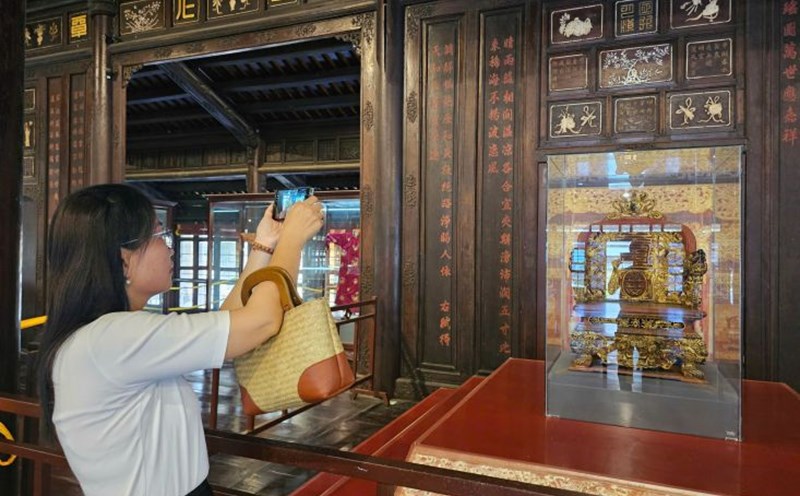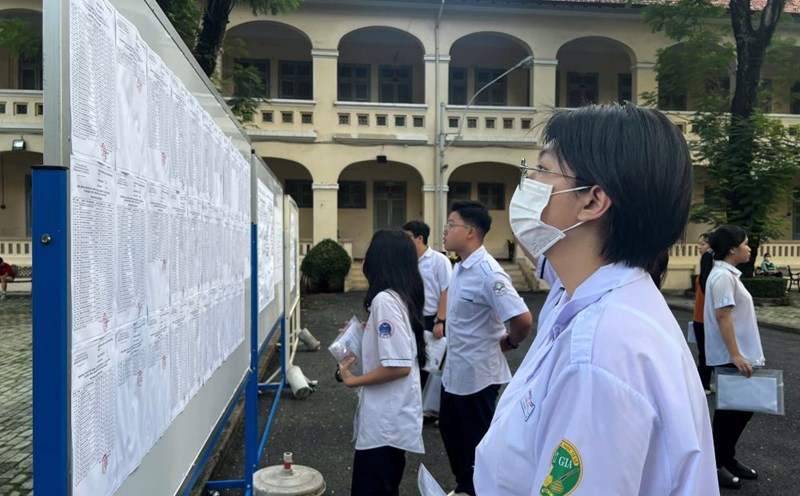Not simply recording or taking photos, these business trips carry both responsibility and concerns: How to make those heritages not only kept in accordance with standards in museums and relics but also preserved in the hearts of the community.
In June 2025, reporters from Lao Dong Newspaper spread from the pagoda to the large museum, to record the status of national treasure conservation.
At Nhat Tao Communal House, the ancient bell is recognized as a national treasure and is being kept and preserved in a secret place, only the Board of Directors of Nhat Tao Communal House Relic knows clearly. A replica bell of the Nhat Tao bell - about 95% similar to the original - is placed in the communal house for people to come to pay their respects and can admire and learn.
Mr. Nguyen Van Bay - Head of the Relics Department - shared: "The original Nhat Tao bell is only brought out on 3 major holidays, including the village festival (Huality Lunar New Year), the Year's Day (September Lunar New Year) and when the Ministry of Culture, Sports and Tourism inspects (1 - 2 times/year). Every time the original bell is brought publicly, it must go through many procedures, all of which are complete to ensure absolute safety for the museum.
The management board must ensure strict procedures for each display of national treasures, and cannot put faith in luck.
That caution partly reflects the common concern in the museum and relic system: Invaluable items are facing many risks - from weather, environmental factors, to human awareness.
During their work, the group of reporters witnessed many paradoxes. The display of the artifact protection glass cabinet is outdated, there is no use of high-quality glass, no standard humidity and temperature control system to prevent the treasury from worn down due to oxidation. Security monitoring systems sometimes only operate for form, lacking funding and human resources.
From the series of articles reflecting the press, there have been more objective perspectives revolving around the story of national treasure protection. After the mass media reported the situation of many historical relics and national heritages being encroached, the Ministry of Culture, Sports and Tourism issued an official dispatch, requesting localities to strengthen management, protection and promotion of the value of historical - cultural relics and scenic spots. The Government directs the review and assessment of the overall work of displaying, preserving, protecting, and ensuring the security and safety of national treasures nationwide.
But for the reporter, this journey does not stop at reflection. It is also an in-depth dialogue with heritage. At Quan Thanh Temple, when admiring the national treasure of Huyen Thien Tran Vu statue in the dark space, the writer could not help but think about the layers of dust from time and silently made efforts to preserve the 4-ton statue, preserving the art works of Ngu Xa bronze casting artisans 3 centuries ago. Or at the Thang Long Heritage Conservation Center, the soft fence around the national treasure of the Ministry of the Golden Temple during the Early Le Dynasty not only prevents visitors from entering the footsteps but also forms the boundary between knowledge and unconsciousness in the story of heritage protection.

A detail that will always be remembered by the writer is the story of Mr. Nguyen Van Kinh - Director of the Florida Glass Museum, the first person recognized by the State to own a private National Treasure. Responding to the question "How to manage and preserve national treasures in Vietnam well?", Mr. Kinh admitted that only when heritage is preserved in museums can it be guaranteed to be in its original state. As for the artifacts owned by Mr. Kinh, the way of preserving, caring for, and preserving the treasures is carried out in accordance with State regulations. The storage process is complicated, requiring a lot of money to invest in machinery.
Not only the story of protection, from the survey's practice, it can be seen that the preservation of national treasures cannot only be on paper, in the law, but needs a synchronous strategy from protection to conservation, promotion: From building a well-trained preservation and protection team, to investing in digital technology in building a national digital database, connecting and updating regularly; applying virtual reality, AI to introduce treasures in interactive spaces, opening a new form of display for the public. Reporters, to some extent, have also become a bridge between heritage and the public, between practice and policy.
Working in the middle of heritage is a special journey. It is not an ordinary hoarding, but a process of touching the depth of national culture, where each artifact contains a part of history, memory and Vietnamese identity. For the reporter, each article is not only a career milestone, but also a commitment: to continue to accompany those who silently preserve the soul of the nation, so that heritage not only lives in a glass closet, but is present in the hearts of every Vietnamese person, so that each person not only loves and understands but also has a sense of protection.











